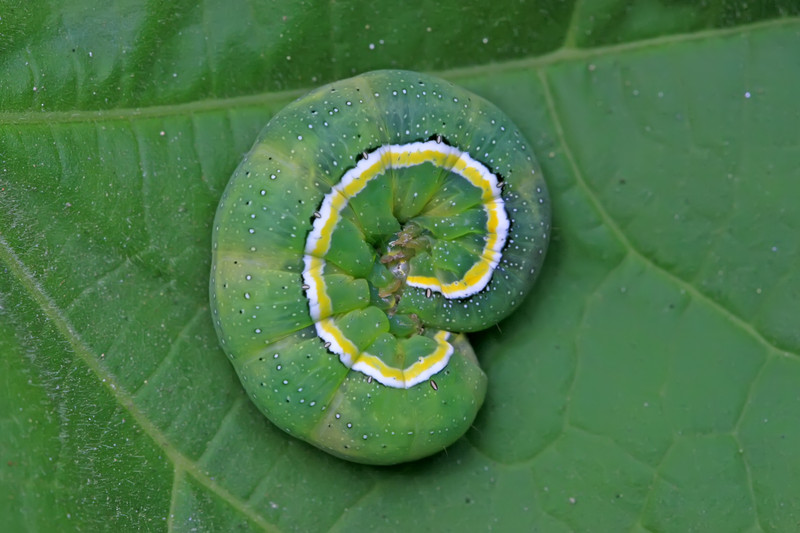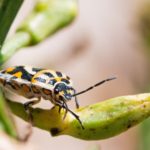Beet armyworm caterpillars are green with yellow undersides and dark green and yellow stripes. Fall armyworms are shiny brown with black heads and yellow stripes down their backs with a V-shaped white mark on the head.
Armyworms are active at night and on overcast days. They get their name from their habit of marching in troops, devouring the leafy vegetation in their path. Armyworms are 1 to 2 inches long and fond of leafy vegetables.

Beet armyworm adults are pale, gray-brown moths with a white dot in the center of the forewing; they have a wingspan of 1½ to 2 inches. Fall armyworm adults are gray, mottled moths (females have pinkish or white wing margins) with 1½-inch wingspans.
Good Products for Pest and Disease Control at Amazon:
- Garden Safe Snail and Slug Bait
- Bonide Sulfur Fungicide
- Monterey BT Caterpillar Killer
- Neem Bliss 100-% Cold Pressed Neem Oil
- Safer Brand Insect Killing Soap
- PyGanic Botanical Insecticide
Beet armyworm moths lay greenish-white eggs in masses on the lower leaves of target plants. Fall armyworm eggs are covered with hair and laid in groups of 50 to 150 on host plants. After hatching the caterpillars feed for several weeks then pupate in the soil. Depending on species and climate there are one to six generations each year.
Armyworms are found east of the Rockies in southeastern Canada, also in New Mexico, Arizona, and California. Beet armyworms are common in the southern United States.
Armyworms are also known as climbing cutworms.
Scientific name: Spodoptera exigua (beet armyworm); Spodotera frugiperda (fall armyworm, budworm); Family Noctuidae.
Target plants
Beet armyworms feed on beets, corn, peas, peppers, spinach, tomatoes, and vegetable seedlings; fall armyworms feed on beans, beets, cabbage, corn, cucumbers, potatoes, spinach, sweet potatoes, tomatoes, turnips, and other vegetables.
Feeding habits and damage
Armyworms chew foliage and buds leaving the tips of leaves ragged. Armyworms feed on seedlings just below the soil surface or just above it, severing the stems. Armyworms travel and feed in large groups.
Organic controls
Handpicking armyworms is very effective. Apply Bacillus thuringiensis var. kurstaki (BtK) to serious infestations. Use neem oil spray as a last resort on large infestations.
Organic control calendar
Here is what you can do seasonally to control armyworms:
- Before planting: Get rid of grassy weeds, since infestations often start there. Set out commercial insect traps with floral lures to attract the moths to the traps. Dig a steep-sided ditch at least 6 inches deep around the plants you want to protect; the armyworms will fall in and then be unable to climb out.
- At planting time: Plant as early as possible to be ahead of the armyworm emergence. Plant early-maturing corn varieties. Attract native parasitic wasps and flies. Spray Bt in midsummer to kill the eggs of the second generation.
- While crops develop: Wipe egg masses off of plants and crush them. Look for caterpillars in the whorl of corn plants and the centers of lettuce, spinach, and other rosette-forming crops. Spray plants with kaolin clay before armyworms appear; kaolin clay will discourage moths from laying eggs. Handpick armyworms. Apply Bt var. kurstaki or spinosad as soon as you see larvae.
- After harvest: Cultivate the soil to expose pupae to the cold, birds, and predator insects.
Natural predators
Trichogramms wasps, lacewings, ladybugs, minute pirate bugs.
Related articles:
Vegetable Garden Organic Pest Control
Vegetable Garden Diseases Problem Solver
Garden Planning Books at Amazon:
- Vegetable Garden Almanac & Planner
- Kitchen Garden Grower’s Guide Vegetable Encyclopedia
- Vegetable Garden Grower’s Guide
- Tomato Grower’s Answer Book















